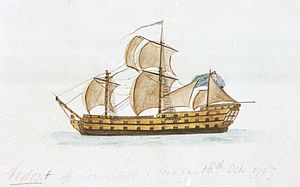HMS Ardent (1796)
 Ardent off Lowestoft on 16 Oct 1797
| |
| History | |
|---|---|
| Name | HMS Ardent |
| Builder | Pitcher, Northfleet |
| Launched | 9 April 1796 |
| Acquired | March 1795 (on the stocks)[1] |
| Honours and awards |
|
| Fate | Broken up, 1824 |
| General characteristics [2] | |
| Class and type | 64-gun third rate ship of the line |
| Tons burthen | 141624⁄94 (bm) |
| Length |
|
| Beam | 43 ft 0 in (13.11 m) |
| Depth of hold | 19 ft 10 in (6.05 m) |
| Propulsion | Sails |
| Sail plan | Full rigged ship |
| Armament | |
HMS Ardent was a 64-gun third rate ship of the line of the Royal Navy, launched on 9 April 1796 at Northfleet. She had been designed and laid down for the British East India Company who was going to name her Princess Royal, but the Navy purchased her before launching, for service as a warship in the French Revolutionary War.[3]
Career
In May 1797 while lying at the Nore she was caught up in the Great Mutiny, she played a minor part but at one point was fired upon by the mutineers on HMS Monmouth.[4]
On 11 October 1797 she took part in the Battle of Camperdown.
In 1801, Ardent took part in the Battle of Copenhagen.
On 28 November 1803, Ardent gave chase to the corvette Bayonnaise in Finisterre Bay. The corvette's crew ran her ashore and then set fire to her prevent the British from capturing her. Captain Winthrop of Ardent described Bayonnaise as a frigate of 32 guns and 220 men, which had been sailing from Havana to Ferrol.[5] Actually, Bayonnaise was armed en flute with only six 8-pounder guns, and was returning from the Antilles.[6]
In 1808 she was assigned to convoy duty, escorting British merchantmen between The Nore and Gothenburg.[7]
Fate
She was placed on harbour service in 1812. In 1813 she was converted into a prison hulk at Bermuda. In 1824 she was broken up there.[1]
Citations and references
Citations
- ^ a b Hackman (20010, p.117.
- ^ Winfield (2008), p.104.
- ^ Lavery, Ships of the Line, vol. 1, p. 186.
- ^ "The Great Mutiny at the Nore". kenthistoryforum.co.uk. Retrieved 9 May 2018.
- ^ "No. 15660". The London Gazette. 24 December 1803. p. 1821.
- ^ Winfield and Roberts (2015), p.172.
- ^ Barney (2009), p.436.
References
- Barney, John (November 2009). "North Sea and Baltic Convoy 1793-1814: As Experienced by Merchant Masters Employed by Michael Henley and Son". Mariner's Mirror. 95 (4). Avenel, NJ: The Society for Nautical Research: 429. doi:10.1080/00253359.2009.10657115.
{{cite journal}}: Cite has empty unknown parameter:|coauthors=(help) - Hackman, Rowan (2001). Ships of the East India Company. Gravesend, Kent: World Ship Society. ISBN 0-905617-96-7.
{{cite book}}: Invalid|ref=harv(help) - Lavery, Brian (2003) The Ship of the Line - Volume 1: The development of the battlefleet 1650-1850. Conway Maritime Press. ISBN 0-85177-252-8.
- Winfield, Rif (2008). British Warships in the Age of Sail 1793–1817: Design, Construction, Careers and Fates. Seaforth. ISBN 1-86176-246-1.
- Winfield, Rif & Stephen S Roberts (2015) French Warships in the Age of Sail 1786 - 1861: Design Construction, Careers and Fates. (Seaforth Publishing). ISBN 9781848322042
